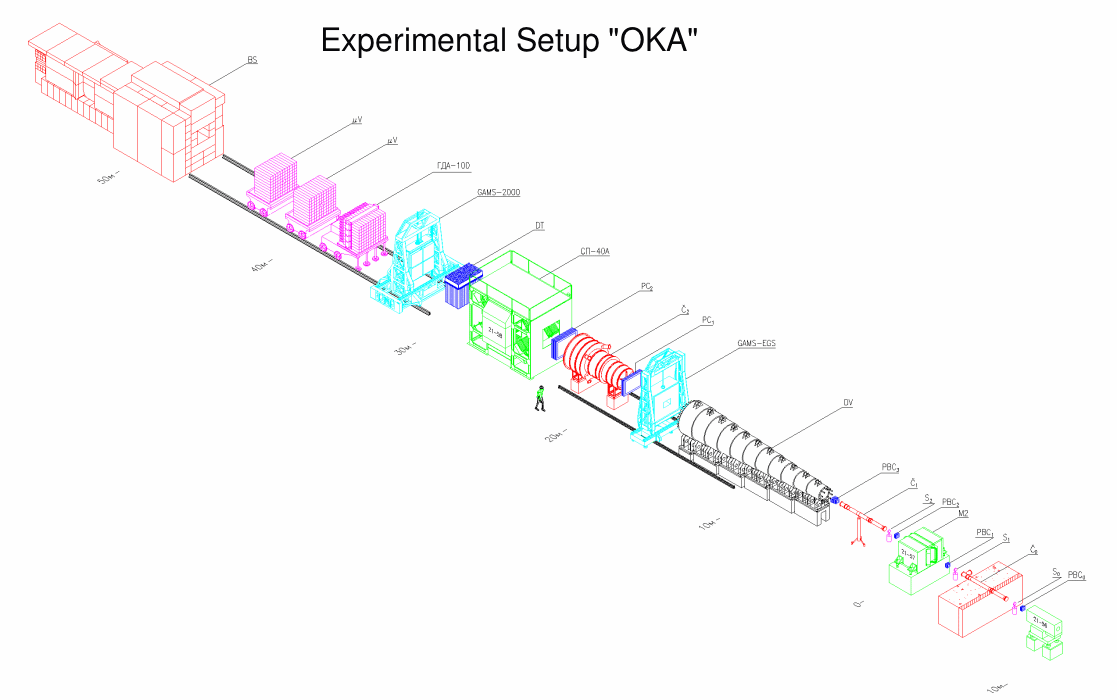Experiment OKA
Welcome to the central OKA portal!
Preface
The site is the central portal of experiment OKA established for investigations of rare Kaon decays. Being one of the particle physics experiments it helps to understand fundamental properties of matter the Universe consists of and to build a scientific picture of the World.Organization
The experiment is placed in Institute for High Energy Physics (Protvino, Russia) with U70 as accelerator and unites physicists from IHEP, Joint Institute for Nuclear Research (Dubna, Russia) and Institute for Nuclear Research (Troitsk, Russia).General Info
OKA proposal (sorry, in russian only).OKA 3D view
OKA photos, cryogenics photos
Prehistory
OKA is the successor of experiment ISTRA-M on which they acquired about 109 triggers. The results of data processing being performed currently are here.Results
Upper Limit on the K+ → π0 π0 π0 e+ ν Decay
JETP Lett. 120 (2024) 8, 554-558,
arXiv:2409.08817
Ограничение на относительную вероятность распада K+→π0π0π0e+ν
Pisma Zh.Eksp.Teor.Fiz. 120 (2024) 8, 578-582
K+ → π0 μ+ ν γ and K+ → π0 e+ ν γ Decays: Recent Results from the “OKA” Experiment
Phys.Part.Nucl.Lett. 21 (2024) 4, 650-653
Study of K+→π0e+νγ Decay with OKA Setup
Moscow Univ.Phys.Bull. 79 (2024) Suppl 1, 135-137
(Contribution to: Lomonosov 2023)
K+→π0μ+νγ Radiative Decay: Recent Results from the ‘‘OKA’’ Experiment
Moscow Univ.Phys.Bull. 79 (2024) Suppl 1, 131-134,
(Contribution to: Lomonosov 2023)
Search for the K+→π+π0π0γ Decay
Moscow Univ.Phys.Bull. 79 (2024) Suppl 1, 138-142
(Contribution to: Lomonosov 2023)
Observation of K+→π+π0π0γ decay
Eur.Phys.J.C 84 (2024) 4, 345,
arXiv:2310.19652
Searches for the light invisible axion-like particle in K+→π+ π0 a decay
Eur.Phys.J.C 84 (2024) 3, 266,
arXiv:2310.16429
Searches for the light invisible hypothetic pseudoscalar in K+ → π+ π0 P decay
J.Phys.Conf.Ser. 2446 (2023) 1, 012031,
(Contribution to: KAON2022)
Evidence for WZW anomaly in the coherent reaction K+ Cu → K+ π0 Cu
J.Phys.Conf.Ser. 2446 (2023) 1, 012047,
(Contribution to: KAON2022)
Study of the K+ → π0 μ+ ν γ Decay: Preliminary Results from the ‘‘OKA’’ Experiment
Phys.Atom.Nucl. 86 (2023) 6, 1315-1321
Evidence for the Chiral Anomaly in the Coherent Scattering of Kaons on Copper Nuclei
Moscow Univ.Phys.Bull. 77 (2022) 2, 250-251,
(Contribution to: 20th Lomonosov Conference on Elementary Particle Physics)
Measurement of the T-Odd Correlation in the K+ → π0 e+ ν_e γ Radiative Decay at the OKA Setup
JETP Lett. 116 (2022) 9, 608-612,
arXiv:2210.15535
Study of K+ → π0 e+ ν γ decay with OKA setup
Eur.Phys.J.C 81 (2021) 2, 161,
arXiv:2010.07983
The Coherent Production of the (K+π0) System by K+ Beam on Copper Nuclei at the OKA Setup
J.Exp.Theor.Phys. 131 (2020) 6, 928-939, Zh.Eksp.Teor.Fiz. 158 (2020) 6, 1070-1082
Measurement of the K+ → μ+ ν_μ γ decay form factors in the OKA experiment
Eur.Phys.J.C 79 (2019) 7, 635,
arXiv:1904.10078
Study of the decay K+ → π+ π− π+ γ in the OKA experiment
Eur.Phys.J.C 79 (2019) 4, 296,
arXiv:1808.09176
Search for heavy neutrino in K+ → μ+ ν_H decay
Eur.Phys.J.C 78 (2018) 2, 92,
arXiv:1709.01473
Ke3 decay studies in OKA experiment
JETP Lett. 107 (2018) 3, 139-142, Pisma Zh.Eksp.Teor.Fiz. 107 (2018) 3, 147-150,
arXiv:1708.09587
Data acquisition system of the OKA experiment
Instrum.Exp.Tech. 59 (2016) 4, 519-526


